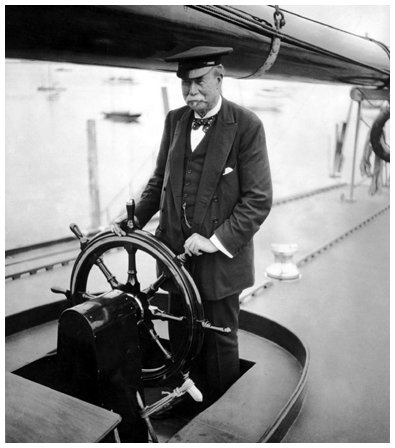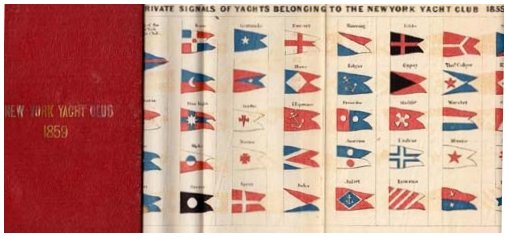Yves GARY Hits: 4799
Category: 1920 : CHALLENGE N°13
Perseverance Has Won Him RichesThese words were spoken in 1914 by that host of geniality, the saltiest of gay sea dogs, Sir Thomas Johnstone Lipton.
Picture a rather tall gentleman, whose skin has been whipped brown by the winds, whose flowing mustache, tinged with gray, cannot dim the lustre of an Irish smile, who walks with just the hint of a sailor's roll and whose eyes carry the half roguish twinkle of eternal youth, and that is Sir Thomas.
"I've had many a try and many a defeat," said Sir Thomas Llpton in an interview to-day with The Tribune correspondent, "but this time I think I have got them."
Sir Thomas thus indicated the optimism with which he regards the chances of Shamrock IV in the coming America's Cup races off Sandy Hook.
"I don't think there is any doubt that the challenge will be accepted," he said, "nor that this will be my time. Of course, the best boat is going to win, but I can say my boat is going to turn the trick. I have every confidence in Captain Burton, who will sail Shamrock. He is an amateur, but has sailed more than a thousand races and has established a famous record.
"Shamrock, as you know, was on her way to America when the war began, and has been laid up ever since. But Mr. Nicholson cabled me before he sailed from America that she has had the best of care and is in the best possible condition. That is all I want to know.
"The American cup defender was built before the war, about the same time as the Shamrock, so there won't be any advantage in point of age for either boat.
"I have sailed Shamrock IV up and down the coast of England and am convinced she Is the best boat afloat. I've another Shamrock which I will send across some time before the date set for the races and which will act as a trial horse."
Sir Thomas is anxious to know as early as possible what date will be set for the races next year.
"There is one thing I want to say as emphatically as possible," he continued. "That is the magnificent treatment I have always received at the hands of the New York Yacht Club. I have always been given the best of everything. Perhaps in the past there have been a few mistakes, but they have generally been in my favor. I have sailed yachts in a great many places, but nowhere have I been better treated and there is nowhere I would rather sail than under the auspices of the New York Yacht Club."
The Irish yachtsman is uncertain when he will go to America. He may not go until shortly before the races next year.
There will be a lot of British money up on Shamrock IV next year. She has been much of a mystery to the British public, but the secrets of her construction are now coming out.
 At the time he spoke of his last thrilling the Shamrock IV was in mid-Atlantic, being convoyed hither by the Lipton steam yacht Erin, where in September it was to have competed against the Resolute, a little bundle of nautical invincibility, off Sandy Hook.
At the time he spoke of his last thrilling the Shamrock IV was in mid-Atlantic, being convoyed hither by the Lipton steam yacht Erin, where in September it was to have competed against the Resolute, a little bundle of nautical invincibility, off Sandy Hook.
It was to have been the fourth Liptonian attempt to take back to the tight little island the most celebrated international yachting trophy. In 1899, again in 1901 and in 1903 Sir Thomas and his especially constructed Shamrocks, with their natty skippers, had failed to "bring home the bacon."
War came. Like a peal of thunder it rumbled across Europe and echoed to England. The Briton dropped his sports and tea to don khaki and shoulder a gun. Yacht racing and other affable diversions were sent into limbo to await that day when a nation that had never learned to love sports or to play them as England and America did should have been taught an indispensable lesson.
After the armistice the Irish baronet again challenged. But it was too soon, the New York Yacht Club thought, and the challenge was temporarily rejected, with the promise that in 1920 a similar overture would no doubt be given not unfavorable consideration.
That time has arrived. The New York Yacht Club is in receipt of Sir Thomas Lipton's latest challenge, and in due course arrangements will have been completed again to defend the cup which the America won off Cowes, England, in the historic race against the English in 1851. There will be no deviation from the usual provisions for the race, which means that the two yachts will race under the rules laid down in the deed of gift rather than the universal rules which have been rather assiduously espoused by Sir Thomas.
With nothing to interfere, Sir Thomas Lipton's fourth attempt to lift the America's Cup should be sailed next summer, probably in June, with Shamrock IV, which the Irish sportsman already has designated as his yacht, competing against the Resolute, which was completed in 1914 to defend the cup.
 The conditions governing the international contests for the America's Cup, as laid down by the New York Yacht Club, provide that the first yacht to capture three races will be the winner.
The conditions governing the international contests for the America's Cup, as laid down by the New York Yacht Club, provide that the first yacht to capture three races will be the winner.
The first race will be sailed to-day, the second on Saturday and the third on Tuesday. If further races are necessary they will be sailed over the Sandy Hook course on July 22 and 24.
The first, third and fifth races, if a fifth should be necessary, are to be sailed over a windward and leeward course, each leg being fifteen miles.
The second and fourth races will be sailed over a triangular course of ten miles to the leg.
The start of to-day's race will be from a mark off Ambrose Lightship.
In every race the preparatory signal will be set on the committee boat Baryton at 10:45 a. m., standard time, which means 11:45 daylight saving time. The warning signal will follow ten minutes later and the starting signal will be raised five minutes after that. This will send the racers away at the stroke of noon.
A period of two minutes follows the starting signal, during which the yachts may start and have their actual time taken. If either yacht fails to cross the line within the prescribed two minutes she will be penalized for the delay, the boat's time being taken two minutes after the even hour.
The rules provide a time limit of six hours for the thirty-mile race, and if neither boat finishes within this time the contest is declared off.
If weather conditions should be deemed unfavorable, the race committee has the right to postpone the start. In this event the skipper of either yacht has the right to insist that a race be sailed.
 If either yacht should meet with a serious accident before the starting signal is raised she may have as much as four weeks in which to make repairs. The length of this time would be fixed by representatives of the New York Yacht Club and the Royal Ulster Yacht Club, the organizations represented by the American defender and the British challenger. If an accident should occur during a race, the time in which repairs may be effected can be extended to October 31.
If either yacht should meet with a serious accident before the starting signal is raised she may have as much as four weeks in which to make repairs. The length of this time would be fixed by representatives of the New York Yacht Club and the Royal Ulster Yacht Club, the organizations represented by the American defender and the British challenger. If an accident should occur during a race, the time in which repairs may be effected can be extended to October 31.
If either yacht should be disqualified during a race the contest will be awarded to her opponent, whether the latter finishes within the prescribed time limit of six hours or not.
If one of the yachts, through the fault of the other, should be disabled the one injured will be awarded the contest.
No race will be started later than six hours before sunset.
The international code signal G, a yellow and blue flag, will be hoisted aboard the committee boat to signify a postponement of fifteen minutes. If the contest is postponed for the day the code signal H, a red and white flag, will be raised.
The hoisting of the blue pater will be the preparatory signal and a Iong blast of the committee boat's whistle will be blown to attract attention to it. The warning signal will be indicated by the hoisting of a white ball followed by another blast of the whistle.
 The raising of a red ball will be the starting signal.
The raising of a red ball will be the starting signal.
When the Shamrock crosses the starting line the red ball will be lowered a few feet to indicate that she has gone over. The white ball will be lowered a similar distance when the Resolute crosses the line. If either ball should not be lowered it will indicate that the yacht she represents has not crossed the line properly.
If either ball should be hoisted above the code signal B, a red flag, it will indicate that the yacht has been disqualified by the committee.
The start will be made over an imaginary line between the committee boat and Ambrose lightship, the courses being designated by signal.
Compass courses are to be magnetic, and signals for a triangular course are to read beginning forward.
